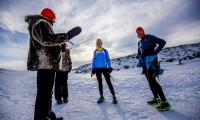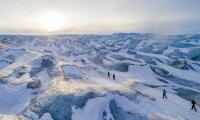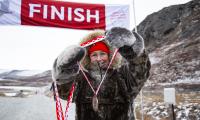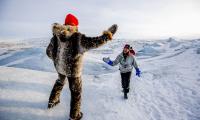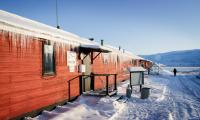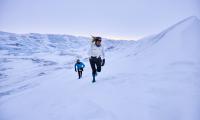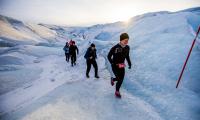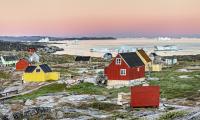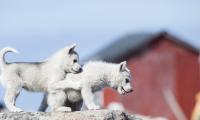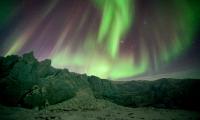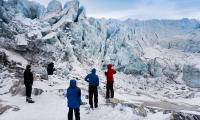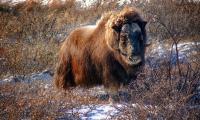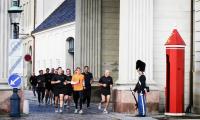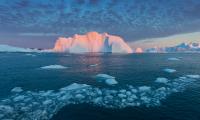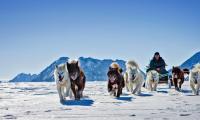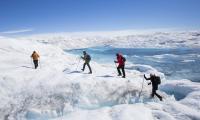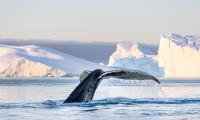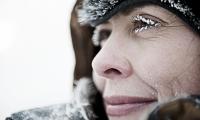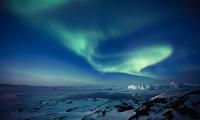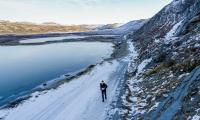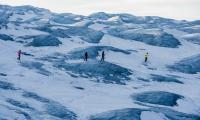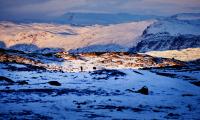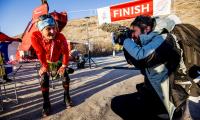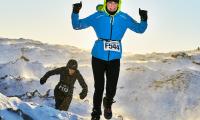Destination Guide
If you do not find the answer you're seeking, feel free to contact us with your question.
LanguageWest Greenlandic |
Capital CityNuuk |
Inhabitants56.000 |
ReligionProtestant |
CurrencyDanish Crown (DKK) |
Area2.166.086 sq. km. |
Special Dietary Requirements
We understand that allergies and special diets are a common concern among our guests. We do our very best to accommodate any diet for medical, allergy or religious needs; however, we cannot guarantee that all dining establishments can fulfill special requests. As a result, we encourage our guests to take all necessary precautions during their travel. Please also keep in mind that Greenland is a remote island where vegetation does not thrive, and thus fresh food must be imported. This means that access to specific foods can vary depending on location and season. However, the tourist industry is well developed and ordering diet-based food in advance is a possibility.
Guests with special dietary requirements should inform their server upon arriving at the location. To facilitate this, we strongly recommend bringing a description of your dietary needs, which has been translated into the local language. When present, your Albatros tour leader can also help inform local eateries of any special requests.
If you require a special diet during your travel, please inform us by providing further information below.
Please note: This information must be received no later than 45 days before your tour begins.
Language
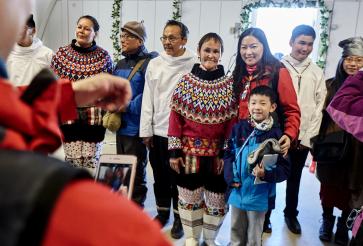
The shortest distance between two people is often a smile, and this is true in Greenland as well. English is widely spoken, but it is relatively easy to communicate even with those that don't.
The official language in Greenland is the West Greenlandic dialect, Kalaallissut. Danish was previously an official language, so most Greenlanders speak Danish to some degree as well.
Electricity
In Greenland, you'll find most power sockets to be standard, two-pronged European plugs. The types of sockets most widely used include Type C, F, E and K. Voltage in Greenland is 230V/50HZ. If the outlet voltage in your country is between 220-240V, you should be fine. However, if it is range of 100-127V (which is common in the US, Canada, and countries in South America), you might need a voltage converter in Greenland. Please note that power plug adapters only convert plug types and do not convert voltages.
The exception to the standard is socket Type K, which is of Danish origin and includes a third prong below the top two. Plugs of Type C will fit (Standard European), but it is incompatible with Types E and F.
If you are bringing a laptop or similar portable device to Greenland, be sure to check the labeling on the power pack. It should describe the amount of voltage your device can handle, and if a voltage converter is required.
Telephone & Internet
For most travelers, a trip to Greenland represents getting away from the daily hustle and bustle, cutting back on connectivity and gaining a fresh perspective. This being said, Greenland is still a technologically advanced land that offers modern communication capabilities.
Telephone
The international country code for Greenland is +299. Roaming is possible, but Greenland is an expensive place to roam from, so it is not recommended if you want to keep costs down.
Internet
Internet access is available at all three hotel options in Kangerlussuaq. In general, hotels and larger restaurants will have WiFi. Usually it must be purchased, and it is also expensive.
Food & Water
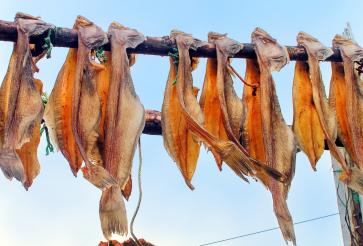
The drinking water in Greenland is some of the cleanest in the world, so the tap water is safe to drink. In fact, you can even drink from the rivers!
Greenlandic cuisine is traditionally based on fishing and hunting, meaning this is a meat-loving society. Marine mammals, game, and fish are part of the general diet because of their high level of protein, with seafood being the main source due to its accessibility. The national dish of Greenland is suaasat, a traditional Greenlandic soup, often made from seal, or from whale, reindeer, or seabirds.
What if I’m vegan / vegetarian, or have other health requirements?
Vegetarians who eat fish will enjoy the feast all year long, but those with other nutritional preferences or health requirements should keep in mind that vegetables (and food that isn’t from the sea) are mainly imported. Most accessible vegetables are canned or frozen, but in bigger towns you will be able to find fresh produce, keeping in mind that due to cargo rates, it might be more expensive than usual.
What to Pack?
As any Nordic mother will tell you, "there's no such thing as bad weather - only bad clothing." This saying is certainly applicable to Greenland. One thing we will repeat is: layers, layers, layers. We're above the Arctic Circle, and one should always be prepared for the weather to change rapidly - when you're too warm, it's easy to shed an extra layer, but it's much harder to warm up when you're too cold.
Another point to stress is wind chill. While the temperature itself might not look too intimidating, the presence of wind can rapidly make it feel much, much colder than the thermometer reads. A warm, windproof winter jacket is essential for staying comfortable as you explore.
Race Day Clothing
Please read the information in "Clothing" under Race Information for a full description and brand recommendations.
Note: Shoe spikes are mandatory for running on the ice. You can either bring your own or purchase them from Albatros Adventure Marathons™ when making your booking, in which case you will receive them upon arrival in Kangerlussuaq.
In terms of clothing, there are no specific requirements, but the medical team and race officials do have the right to stop and take out a runner who is not dressed properly for the weather. Layers are key to a good race and to keeping you as dry and warm as possible. You need to be prepared for changing weather. How many layers you wear is an individual matter and weather dependent, but a minimum of 3 layers is recommended.
Remember: Cotton is your worst enemy when running in an arctic climate. Cotton retains water and will make you very cold, as well as rub your skin raw. Do not wear cotton clothing during the Polar Circle Marathon and Half Marathon. Choose instead technical fabrics or merino wool.
Base/Inner Layer (sweat-transporting layer):
Must be a functional thinner layer that transports sweat away from your body (called moisture-wicking) and dries fast. Make sure it’s comfortable to wear and doesn’t restrict you in your movements. Avoid base layers with zippers that touch the skin.
Mid Layer (insulating layer):
Should be a loose weave fabric or fleece with additional thermal insulation thicker than your base layer. Again it’s important that it doesn’t restrict your movements, especially with the outer layer on top.
The mid layer should provide warmth and breathability. Again it’s important that moisture is transported to the outside/next layer. Some mid layers even have wind protection, but this is not a must as you won’t be running without your top layer when windy.
Top/Outer Layer (weather-protective layer):
The top layer can be divided into two categories: soft shell and hard shell. Regardless of what you choose, wind protection is the most important thing. Water resistance is a benefit too in case it snows.
While soft shells are now being manufactured with better wind and water resistancy, they’re still not as efficient as a hard shell. The hard shell on the other hand, does not have the same breathability as the soft shell, although development of vent zones does allow for more airflow and thus minimize the risk of wet and cold mid- and base layers.
In extreme wind conditions starting in both a soft and a hard shell can be advisable, but it is also very likely that you will soon be too warm and will need to drop one of them.
Legs:
Three layers on your legs are likely to be too much. The top layer on your legs must have wind protection and preferably thermal functionality. A base layer under a winter tight will work if the tight has wind protection. Alternatively a normal winter running tight may work fine as base layer under a pair of windproof running pants.
Running without wind protection on your legs may cause frostbite on knees, thighs and other lower body parts.
Gloves:
Again, wind protection is the most essential, but of course your gloves should be warm too!
Make sure your gloves aren’t too tight around your hands and fingers – it’s better for airflow between your skin and the fabric. Layers will be an advantage in very windy conditions with inner gloves under a warmer and looser pair of outer gloves or mittens.
Hand warmers are an option, but as we try to leave as little a footprint as possible on our race site we recommend the reusable solutions over the disposable versions.
Head and neck:
A winter hat is an absolute must. It should cover your ears too. Some prefer a functional moisture wicking hat while others opt for warmer traditional winter hats. A hat of 100% wool will have both features, but may be itchy for some people.
The neck should be covered with a scarf or a neck tube/buff. It’s important that the scarf/buff can be drawn up over the mouth and nose in case of strong winds. However, running with your nose and mouth covered for a longer time will cause condensation and make your face more prone to frostbite.
Balaclavas and buffs with air holes for mouth and nose are available, but even these will eventually turn in to an ice mask. If windy and necessary to cover your face make sure you actively remove the ice building up on your cover. A spare scarf/buff at the personal supply station is advisable. Star Wars fans may invest in a ColdAvenger.
The use of tape on cheek and nose is not recommended. There’s no evidence that this will prevent frostbites, but it will definitely prevent the medical team from seeing signs of frostbite.
Sunglasses or light ski goggles will be a relief in sunny, windy, and/or snowy conditions.
Feet:
Your feet are the least exposed part of your body as you’ll be constantly moving sending a lot of blood to your feet and toes. We do recommend, however, that you wear warm running socks, potentially with a thin liner sock underneath. Make sure the sock is high so there’s no open skin gap between sock and tights/pants. A spare pair of socks at the personal supply station is advisable.
If the ice sheet is covered in a thick layer of snow gaiters will keep it out of your shoes, but cheaper solutions like a plastic bags inside your shoe may do the trick. If you’re prone to blisters the plastic bag may cause too much friction.
Tipping Guidelines
All prices in Greenland generally include a service fee, so it is not necessary to tip.
Of course, if you are exceptionally pleased by a guide or a restaurant, gratuity is appreciated.
Currency and Daily Expenses
Greenland uses the Danish Crown as currency (DKK). Please note that it is not possible to pay with other currencies. There is a copious amount of ATMs in Copenhagen that guests can access before we leave, and otherwise there is an ATM in Kangerlussuaq airport as well as in the town of Ilulissat.
Most places in the larger towns (such as Ilulissat) will accept credit cards. That said, some smaller stores may only accept cash, so it is a good idea to have some on hand.
The cost of our travels include many meals. Breakfast is included every day that you will be at the hotel, and several lunches and dinners are included as well. Any meals that are not included on the ititnerary must be purchased individually. For this, keep in mind that as an isolated island, the cost of living in Greenland is generally higher than normal. A standard meal at a local restaurant costs between USD 15 to 25 per person.
In terms of extra travel money, it is our experience that you can manage for approx. USD 20 to 40 per day. For this amount, you can cover the cost of supplemental drinks, food, snacks, postcards, stamps, etc. If you intend to purchase souvenirs and gifts, plan to spend more.
Etiquette
In general, Greenlanders are friendly and welcoming to visitors. If you act kindly and with respect, there are not too many special rules to abide by.
As visitors, it is important to know that the indigenous population are called Inuit and not Eskimo.
Also, please note that sled dogs are not pets - they are working animals and should never be approached.
Medical Facilities
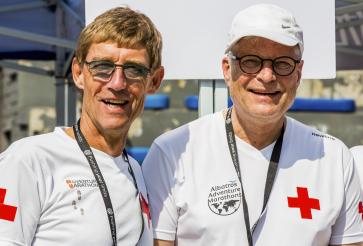
There is a medical clinic in Kangerlussuaq, a regional hospital in Ilulissat, and a national hospital in Nuuk.
Medical assistance during the marathon event
A team of English-speaking Danish doctors will be present during the pasta dinner and the race. The medical team is ready in case of injury, frostbite, or severe exhaustion.
Albatros Adventure Marathons™ will ensure that an English-speaking doctor/medical team is available for participants of our marathon events. If any treatment is unable to be carried out by the doctor and it is necessary to refer a participant to local medical facilities, the doctor/medical team and travel agency will not be held liable for any treatment carried out by staff from local medical facilities.
Visas
As a general rule, if you do not need a visa to enter Denmark, then you do not need a visa to enter Greenland. That said, all participants are responsible for checking themselves if their nationality requires a visa or not, and are also responsible for obtaining the visa if so.
If you do require a visa to enter, please note that Greenland is not a part of the Schengen agreement, and thus standard Schengen visas are not valid for entry - you need one from the Danish consular with a special 'valid for Greenland' stamp.
Your passport also must be valid for 3 months beyond your planned departure from Greenland.
You can find the list of visa-free countries and visa-required countries here.

